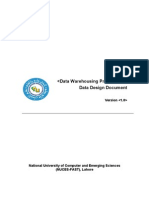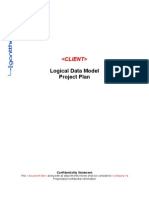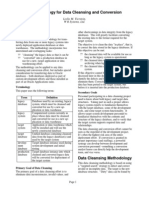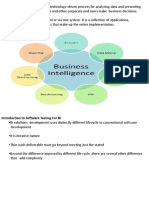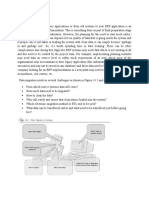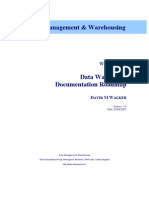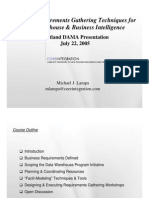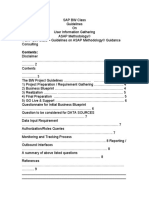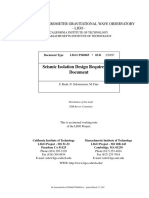DWH Project Documentation Template
DWH Project Documentation Template
Uploaded by
Hussnain SarmadCopyright:
Available Formats
DWH Project Documentation Template
DWH Project Documentation Template
Uploaded by
Hussnain SarmadOriginal Title
Copyright
Available Formats
Share this document
Did you find this document useful?
Is this content inappropriate?
Copyright:
Available Formats
DWH Project Documentation Template
DWH Project Documentation Template
Uploaded by
Hussnain SarmadCopyright:
Available Formats
TEMPLATE FOR DATA WAREHOUSE PROJECT DOCUMENTATION
Table of contents
List of figures
List of tables
Acknowledgment
Executive summary
1.0 Introduction
The concept phase is about describing what the big idea is. The business may have a concept and
the IT team will be able to describe the major component and concepts of a data warehouse.
1.1 Analysis
The goal of the analysis phase is to identify the sources of the information required to populate
the physical data models. The main goal should be to populate the repository data model as this
is used as the source for all data in the data marts. This is achieved in a number of steps:
1.1.1 Source Systems Analysis (SSA)
The source system analysis is a high-level analysis that gathers information about available
systems. Each system is a potential candidate as a source system and generates its own analysis
document. Some systems may be documented and then rejected e.g. because it is a secondary
source and only contains information created in another system that can be used as the source.
The document covers hardware, software, network connectivity, availability and functional areas
(e.g. CRM system containing customer data etc.).
1.1.2 Source Entity Analysis (SEA)
The source entity analysis is the detailed documentation of the sources selected because data
profiling has validated these sources as being useful for the data warehouse. This includes
detailed information about every table and column, including data types and data quality metrics.
A source entity analysis will be produced for each system that is to be used as a source.
2.0 Requirements
The requirements gathering phase of any data warehouse is one of the most difficult. The
objective of these templates is to give breadth and depth to the requirements. Breadth is the
ability to ensure that all truly required information would be covered, whilst depth is the amount
of detail that is specified in the requirements to ensure that the developers have sufficient,
unambiguous, detail with which to develop. Requirements should have a programme-long life
cycle. After the initial version of the requirements is developed a project can start the build,
however the business moves on and therefore whilst the build phase is occurring it is important
that new versions of the requirements are also being developed. A project within a programme of
work should have a fixed version of the requirements; however each project may work with a
different version of the requirements.
2.1 Data Warehouse Business Requirements (WBR)
The first template that Data Management & Warehousing use is called the Data
Warehouse Business Requirements and it details the ‘soft’ requirements for business information
according to a number of subject areas of interest to the business. A business requirement is
something of the form: ‘Provide the average and total revenue for each product category by
customer market segment for the last three years’ It is a requirement that is specified in business
language and without regard for the practicalities of delivering it. These requirements should be
used to get business users to underwrite the business benefit, i.e. if I could answer all of these
questions then I would be able to increase margin by a given percentage for a given product.
2.2 Data Warehouse Data Requirements (WDR)
The second document details the ‘hard’ requirements for business information from the
data perspective. This document goes a step deeper into understanding the requirements, but is
still written from the business users’ perspective. This is the refinement of the business
requirements in that the analysts can use the business requirement to drive out the data required
to answer the questions. In the example above it is clear that both some part of the product
hierarchy and of the customer hierarchy are required as well as a time dimension and information
about revenue. It has also told the analyst that the minimum retention period is three years.
Consequently, the analyst would start to build data requirements that may fulfill many business
requirements and to add additional attributes to help make sense of the data. The data
requirements lifecycle is similar to that of the business requirements i.e. fixed for a project and
variable over the lifespan of a programme.
2.3 Data Warehouse Query Requirements (WQR)
The third document lists a number of potential queries to which the solution should be
able to provide answers. This is not an exhaustive list, but rather represents the types of queries
that are being asked by the business. It is used to test the relationship between the data
requirements, the data model and the business requirements. A set of queries should be able to
provide the data required to answer a business requirement. At the same time the data must be
available as described in the data requirements and joined in such a way as to be usable in the
data model.
2.4 Data Warehouse Technical Requirements (WTR)
The fourth document details the functional and non-functional requirements that are
expected of the solution. Again, these requirements are stated from the business perspective
rather than the technical perspective. The document should include topics such:
• The functionality required of the query tools.
• The general retention requirements for data.
• The performance characteristics.
• The systems availability expectations.
3.0 Architecture
The architecture category contains a number of documents that describe how the system should
be built, these provide a blueprint to developers on how to approach any particular problem by
helping them select the appropriate tools, platforms and configurations to both meet their need
and conform to the overall strategy.
3.1 Technical Architecture
The technical architecture describes the technical components that will be used to build
the system. This will include the hardware, software and network configuration, along with
specific versions where appropriate and standards as to which software product should be used
for which job. It also specifies whether two level architecture is used or any other.
4.0 Data Models
Data models are (normally) graphical representations of the data that is required. These
are normally created in special software that can also generate the DDL required to create the
physical objects in the database.
4.1 Data Modeling Standards
This document describes the naming conventions of objects in the database, as well as
any particular modeling methods (e.g., a hierarchy must always be modeled in a specific way and
any exceptions noted along with a justification for the difference). This document should
describe the standards for all three data models described modeling techniques for Logical and
Physical models.
4.2 Information Package
The new methodology for determining requirements for a data warehouse system is based
on business dimensions. It flows out of the need of the users to base their analysis on business
dimensions. The new concept incorporates the basic measurements and the business dimensions
along which the users analyze these basic measurements. Using the new methodology, you come
up with the measurements and the relevant dimensions that must be captured and kept in the data
warehouse. You come up with what is known as an information package for the specific subject
4.3 Conceptual model
The logical data model is a model that represents the true structure of data used by the
business, independent of software or hardware implementation constraints. Normally the model
is closely related to the information described in Data Warehouse Business Requirements.
4.4 Logical Model
The logical data model is a model that represents structure of data used by the business.it
depends upon software or hardware constraints.
5.0 Analysis snapshots
Here 5 to 6 types of analysis and its results are displayed by using snapshots of the created data
warehouse.
6.0 References
In this section, references are provided by using APA format.
You might also like
- Procedures Manual On Utpras Unified TVET Program Registration and Accreditation System Program Registration (Land-Based)100% (3)Procedures Manual On Utpras Unified TVET Program Registration and Accreditation System Program Registration (Land-Based)82 pages
- Template - Phase 1 - Data Design DocumentNo ratings yetTemplate - Phase 1 - Data Design Document11 pages
- Best Practices Data Model Review ProcessNo ratings yetBest Practices Data Model Review Process3 pages
- Data Warehouse Requirements Gathering MethodsNo ratings yetData Warehouse Requirements Gathering Methods1 page
- IBM Banking & Financial Markets Data WarehouseNo ratings yetIBM Banking & Financial Markets Data Warehouse40 pages
- Data Conversion and Cleansing MethodologyNo ratings yetData Conversion and Cleansing Methodology21 pages
- ITD Business Requirements Document - 2013No ratings yetITD Business Requirements Document - 201378 pages
- Data Mapping Diagrams For Data Warehouse Design WiNo ratings yetData Mapping Diagrams For Data Warehouse Design Wi15 pages
- Business Intelligence (BI) Is A Technology-Driven Process For Analyzing Data and PresentingNo ratings yetBusiness Intelligence (BI) Is A Technology-Driven Process For Analyzing Data and Presenting26 pages
- In T e G R A Ti o N: Integration of DataNo ratings yetIn T e G R A Ti o N: Integration of Data21 pages
- Business and Functional Requirements Document Approved Baselined100% (1)Business and Functional Requirements Document Approved Baselined6 pages
- White Paper - Data Warehouse Documentation Roadmap100% (15)White Paper - Data Warehouse Documentation Roadmap28 pages
- Best Practices in Data Warehouse Testing GOODNo ratings yetBest Practices in Data Warehouse Testing GOOD18 pages
- Business Requirements Gathering Techniques For Data Warehouse & Business Intelligence100% (1)Business Requirements Gathering Techniques For Data Warehouse & Business Intelligence33 pages
- Stage: Business Analysis Business Requirements Document: University of EdinburghNo ratings yetStage: Business Analysis Business Requirements Document: University of Edinburgh13 pages
- D R D W S U C: Eveloping Equirements For ATA Arehouse Ystems With SE AsesNo ratings yetD R D W S U C: Eveloping Equirements For ATA Arehouse Ystems With SE Ases7 pages
- Data Warehousing - Notes (Only Till Chapter 5)No ratings yetData Warehousing - Notes (Only Till Chapter 5)54 pages
- Project Management - Techniques in Planning and Controlling Construction Projects, 2nd Edition PDF100% (1)Project Management - Techniques in Planning and Controlling Construction Projects, 2nd Edition PDF518 pages
- Context of The Organization in Iso 9001-2015No ratings yetContext of The Organization in Iso 9001-201516 pages
- SRS REPORT - CS577 Group 6 (Danial, Harith, Azza, Ween)No ratings yetSRS REPORT - CS577 Group 6 (Danial, Harith, Azza, Ween)33 pages
- Download Building a High-Value Health System Rifat Atun ebook All Chapters PDF100% (1)Download Building a High-Value Health System Rifat Atun ebook All Chapters PDF41 pages
- Case Study - Transforming The OrganizationNo ratings yetCase Study - Transforming The Organization5 pages
- Petri Net Synthesis For Discrete Event Control of Manufacturing Systems (PDFDrive)No ratings yetPetri Net Synthesis For Discrete Event Control of Manufacturing Systems (PDFDrive)247 pages
- Driving Performance Via Exploration in Changing Environments: Evidence From Formula One RacingNo ratings yetDriving Performance Via Exploration in Changing Environments: Evidence From Formula One Racing23 pages
- AI and Recruiting Software Ethical and Legal ImplicationsNo ratings yetAI and Recruiting Software Ethical and Legal Implications18 pages
- AVLib A Simulink Library For Multi-Agent Systems ResearchNo ratings yetAVLib A Simulink Library For Multi-Agent Systems Research7 pages
- Buy ebook (Ebook) Approaches To Training And Development (3rd Edition) by Dugan Laird, Elwood F. Holton III, Sharon S. Naquin ISBN 9780738206981, 0738206989 cheap price100% (1)Buy ebook (Ebook) Approaches To Training And Development (3rd Edition) by Dugan Laird, Elwood F. Holton III, Sharon S. Naquin ISBN 9780738206981, 0738206989 cheap price73 pages
- Proposal of Expert System For Hotel Booking SystemNo ratings yetProposal of Expert System For Hotel Booking System4 pages
- Unit-I: Introduction To Software Engineering: The Evolving Role of SoftwareNo ratings yetUnit-I: Introduction To Software Engineering: The Evolving Role of Software21 pages
- Software Engineering Lecture - Sequence DiagramNo ratings yetSoftware Engineering Lecture - Sequence Diagram36 pages
- A Hutchison - Adam Smith and The Wealth of NationsNo ratings yetA Hutchison - Adam Smith and The Wealth of Nations22 pages











